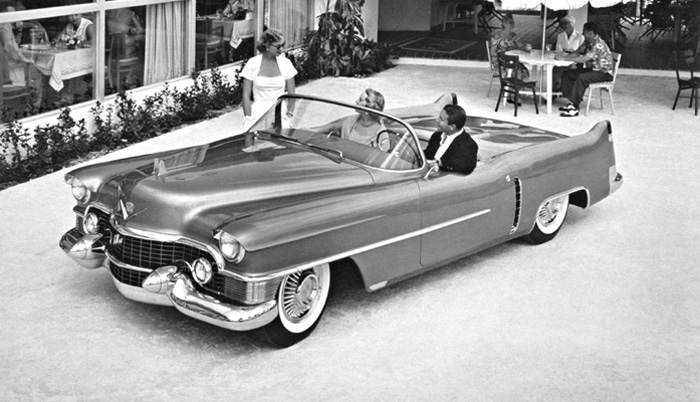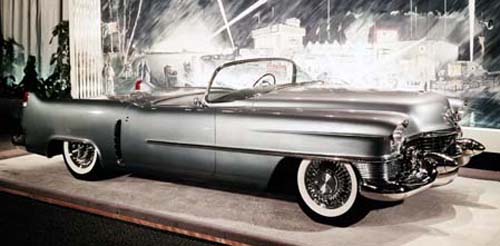|
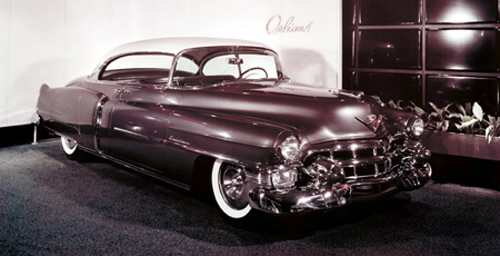
1953 Cadillac Orleans
The Orleans was one of two dream cars built by the Cadillac Studio for the 1953 Motorama. It debuted that year at the Waldorf-Astoria show in New
York City. The Orleans was very similar to the 1953 Cadillac Coupe de Ville in appearance with one significant difference. It was the first pillarless
four-door hardtop automobile to be shown by General Motors. This feature would go into production for the 1955 model year on Buicks and
Oldsmobiles. The Orleans also had a wraparound windshield, a feature that was displayed on many of the other dream cars for 1953 as well, as the production model 1953 Eldorado.
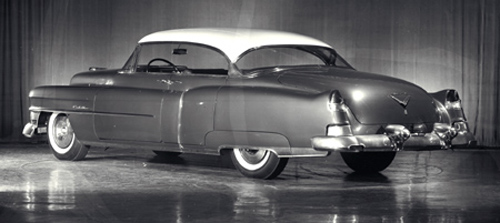
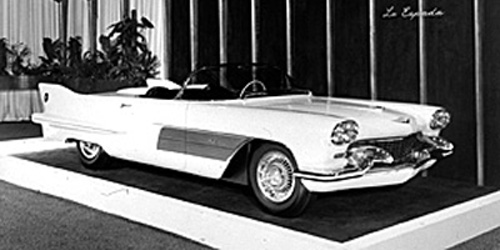
The 1954 Cadillac La Espada concept, was a driveable show car first shown at the 1954 GM Motorama. It was a two-seat fiberglass convertible,
mechanically similar to the El Camino concept coupe but with a specially engineered convertible top, ribbed to create a perfectly curved surface when closed.
La Espada sported a recessed grille air intake in the front, which was guarded by massive and sweeping front bumpers. The bumpers were capped
with white vinyl to cushion shocks and prevent scuffing of the chrome. Ribbed aluminum on the fender sides was slotted to admit air for the air conditioning system.
La Espada, named for the sword, had dual headlights controlled with an Autronic Eye. Below the trunk compartment in the rear of the car was a
special compartment that housed the spare tire. Removing a bright chrome trimmed door, which also served as a bumperette and license plate mount,
accessed it. The gas cap was located behind the left rear tail fin, which swung forward for access.
The experimental sports convertible had a 115-inch wheelbase, a 200-inch overall length and was powered by a Cadillac 230 horsepower overhead valve V8 engine.
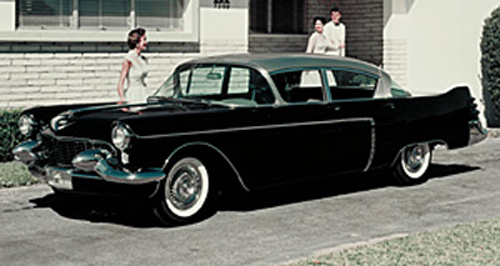
The 1954 Cadillac Park Avenue concept, was a four-door pillarless fiberglass sedan built on the 133-inch wheelbase chassis of the 60 Special
series and was presented at the 1954 GM Motorama at the Waldorf Astoria in New York City.
Noticeable was the return to dual instead of quad headlights. Quads were still illegal in many states until 1958. The tail fins on the Park Avenue are
copied directly from GM's 1951 Le Sabre experimental roadster. The dummy air-scoop on the rear door reappeared on all 1955 Cadillacs and on the Cadillac Eldorado Brougham Town Car prototype in 1956.
The Park Avenue was powered with a 238 horsepower Cadillac V8 overhead valve engine
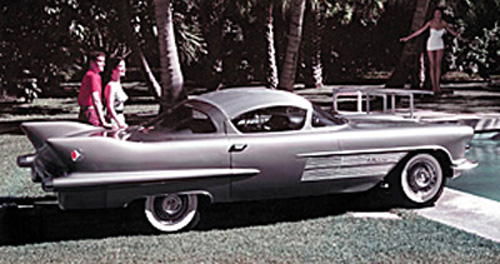
The 1954 Cadillac El Camino concept was a driveable, two-seat show car first shown at the 1954 GM Motorama. It had a fiberglass body and a
brushed stainless steel top, which was a preview of Cadillac styling later that decade. The passenger compartment used a curved glass, aircraft-type bubble canopy.
It was powered by a Cadillac 230 horsepower overhead valve V8 engine. The El Camino had an overall length of 200-inches and an overall height of
51.6-inches and was painted a pearlescent silver color. The interior was covered in gunmetal gray leather and the steering column, horn button and
ring were chrome plated. High backed bucket seats were built into the headrests that flowed back to the rear window.
Several styling cues, such as the shape of the rear fins, the stainless roof, fluted side panels, gull-wing front bumper and quad headlights would show up in future production models.
There was a convertible concept very close to the El Camino called La Espada. The El Camino name, translated in Spanish means "The Royal
Highway", was later used on Chevrolet/s car based production pickup introduced in model year 1959
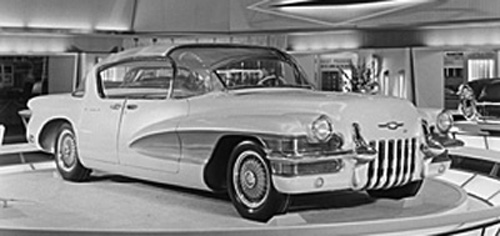
1955 Cadillac LaSalle II Concepts, In 1955, Harley Earl's Art and Color Section created two Cadillac LaSalle II dream cars for display in the 1955
GM Motorama shows. One was a small four-door hardtop sedan. The other was a two-seat convertible roadster. Compact V6 experimental aluminum
engines powered both. Both LaSalles had 1940's style vertical grille openings, Dagmar bumper guards and the LaS insignia as used in the marques' early years.
The hardtop sedan had rear-hinged back doors with seating for six despite a compact 108-inch wheelbase. Overall length was just 180-inches, height
a mere 50-inches. The lowness was partly achieved with 13-inch tires. Other features included unit construction, a big compound-curve windshield, concave body side ellipses and semi-exposed rear wheels.
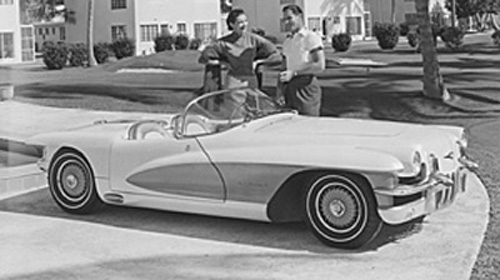
The other LaSalle II, the two-seat roadster convertible, had a fiberglass body with concave body side panels behind the front wheel openings. It was
extremely short with a chopped-off rear end with fully opened rear fenders. Chassis side rails housed the exhaust pipes, which exited just ahead of the back wheels.
Both LaSalle II's were strictly for show and never intended for showrooms. Sent to the crusher, both the four-door hardtop and roadster were instead
hidden in the back corner of a salvage yard and were acquired ca. 1990 by a Chicago area nightclub owner, Joe Bortz, who has made a significant investment in restoring GM Motorama cars.
1959 Cadillac Cyclone Show Car
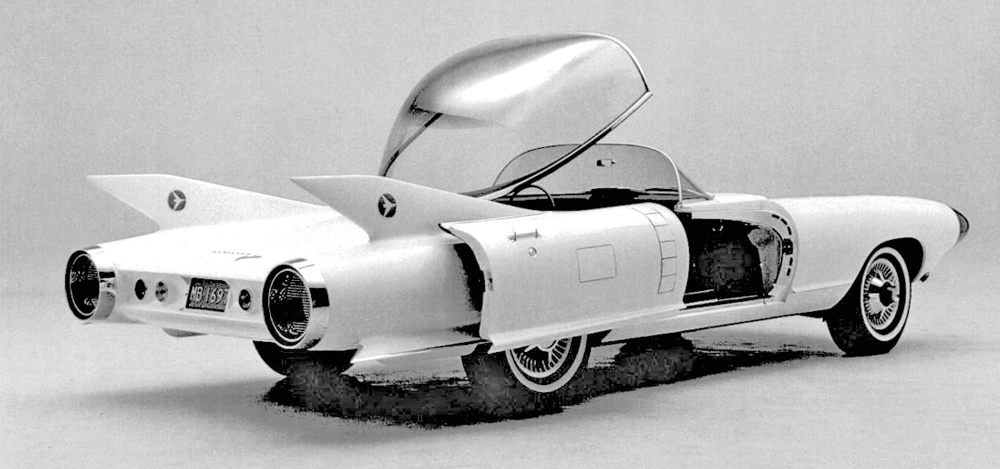
The Cadillac Cyclone is a show car with an aircraft-inspired design, explored futuristic technology. An early version of a crash avoidance system was
the Cyclone's radar-sensing technology that provided the driver with information on an object ahead, including distance to the object and stopping
distance, both measured in feet. When a sensor in the console detected rain, it automatically put up the one-piece bubble top. The Cyclone featured
a front-mounted engine with rear-mounted transmission and transaxle, and also came equipped with automatic climate control
|
